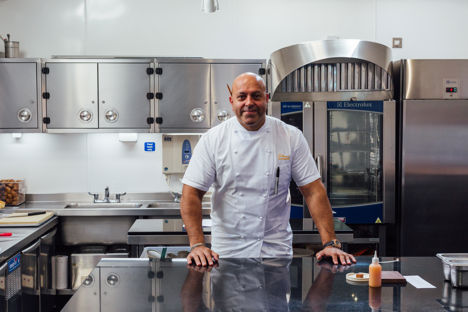
Sat Bains and the science behind his tasting menu
A meal at Restaurant Sat Bains isn’t just a succession of dishes – every plate has been carefully designed to perfectly precede the next. Tom Shingler talks to the chef to find out how much work goes into the flow of the menu.
Sat Bains and the science behind his tasting menu
A meal at Restaurant Sat Bains isn’t just a succession of dishes – every plate has been carefully designed to perfectly precede the next. Tom Shingler talks to the chef to find out how much work goes into the flow of the menu.
The little coloured dots underneath each dish description on the menu at Restaurant Sat Bains aren’t just for design purposes. Each one corresponds to a certain taste – sweet, salty, umami, bitter or sour – and their size indicates just how intense that flavour will be. It’s just one insight into how Sat Bains and his team ensure the tasting menu is as good as it can possibly be. And while almost all chefs can wax lyrical about how they came up with a particular dish (you can read about how Sat came up with his asparagus dish here), only those at the levels Sat is cooking at can talk about their menu as a whole. Individual dishes are developed in the context of how they’ll fit into the tasting menu – the ‘macro’ element of the experience is just as thought through as the ‘micro’.
‘I’ve always tried to work on balance,’ explains Sat. ‘If you’re going to have something rich you want to follow it with something acidic or fresh or clean. The idea ultimately is to have a well-balanced menu – rather than just saying you’ve got these ten dishes and they’re using seasonal ingredients, you have to have a reason as to why they’re in that order. People are paying for an experience; they want to go through this journey of ten dishes and by the end of it be really happy and satisfied.
‘We’ve done a tasting menu for seventeen years so we have to show we know what we’re doing,’ he continues. ‘You can’t just throw stuff together – I’ve been cooking for thirty years now so there’s got to be a level of craftsmanship with what I do. I might only eat the menu in its entirety from a diner’s perspective about four or five times a year, but every day I’m tasting the dishes as they’re cooked. When you’ve spent something like 20,000 hours repeatedly putting out dishes you have to show that you know what you’re doing.’
One of the main ways Sat ensures his tasting menu is always as good as it can be is by, quite simply, listening to his guests. ‘Because we have three different open tables and our front of house team are always keen to get any feedback they can, we can almost immediately get a feel for how someone is enjoying their time here,’ says Sat. ‘I don’t know what people like – I can only put my dishes out there, but the more feedback we take on board the more likely it is that they’re well received. I suppose my aim is to create something like a Japanese kaiseki, which is the most beautiful form of a tasting menu I’ve ever experienced, showcasing beauty, seasonality and craft. I think if we can get anything close to that in a western-style tasting menu, I think we’ve achieved a very high level of understanding.’
Of course, value for money is also incredibly important to keep the restaurant busy – and knowing how big to make the tasting menu plays a major role in making sure everyone leaves satisfied. ‘Do we want guests to be full by the main course, or do we want that to happen after dessert? We have to find the balance and feedback is so crucial to that. The key things we’re looking for are people saying something was too salty, or too cold, or there were bones in the fish, as they’re technical skills and we’ve messed up. But when it comes to more subjective feedback, it’s a lot harder. There could be six people at a table and five of them love a dish and one doesn’t. None of them are wrong – it’s just personal taste. That’s why we work towards getting a 90% success rate on everything we do, allowing 10% failure as we can’t please absolutely everybody. It’s just like music or art.’
Although it rarely happens, Sat makes sure even the diners who don’t like a particular dish still leave happy by ensuring there are always a few back-up dishes which can be served up as a replacement. One thing he has noticed, however, is just how clued-up the people who visit his restaurant have become in recent years, which means he has to work even harder to impress.
‘These are our golden years as chefs,’ he says. ‘Customers travel the world, eat at all the good restaurants and know food because they cook themselves. That ultimately makes our job tougher but it also makes it more exciting and rewarding because we’re trying harder. If you can give someone a beautiful little leek soup with a wild garlic dumpling in it and it’s the best leek soup they’ve ever tasted, you’ve been able to push the flavours in that dish to another level. People want value for money and, at a place like this at least, something a little bit unique.’ And as Sat heads off to check what’s happening in the kitchen, takes us on a quick tour around the kitchen garden and brings out some of the dishes on his current menu, I think it’s safe to say he offers both.

